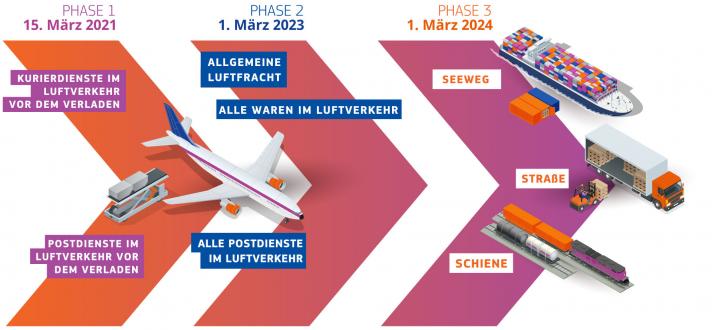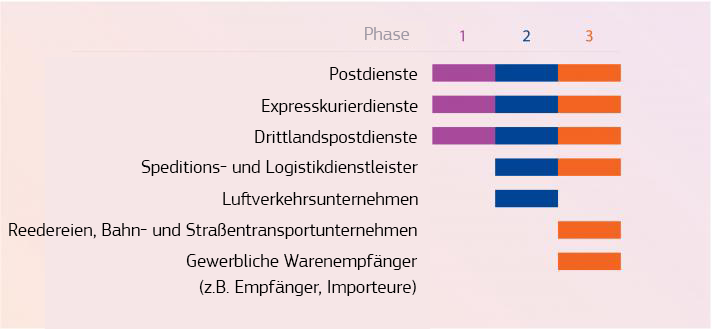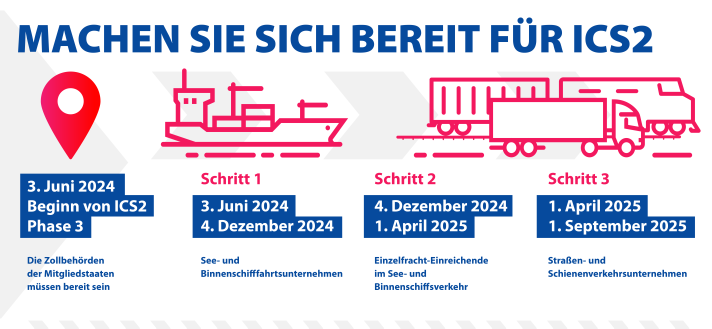New EU security system for monitoring imports
Import Control System ICS2
Between March 2021 and September 2025, the EU customs authorities will introduce ICS2, a new freight information system for risk assessment and security. Via the new IT system, all goods imported into the EU must already be declared before their arrival by means of the Entry Summary Declaration (ENS). The aim is to adapt processes to the provisions of the UCC (Union Customs Code), facilitate the free flow of trade and at the same time increase security in the supply chain.

ICS2 replaces the old ICS in three steps (source: EU website). Attention: EU graphic outdated. Start of phase 3 03.06.2024.
For the first time, a Europe-wide central system will be used for the storage of ENS data (the Common Repository) and communication with traders (Shared Trader Interface). Alternatively, member states are free to provide a national service interface. However, German customs already announced in ATLAS-Info 0137/2021 dated February 24, 2021 that it is relying entirely on the EU solution: “A national subscriber interface is not offered in Germany”.
We’ll keep you up to date on all ICS2 developments and give you an overview of what ICS2 means for you.
Advantages of ICS2
Extract from the official text of the EU website:
ICS2 introduces more efficient and effective EU customs safety and security measures that:
- Increase the protection of EU citizens and the internal market against security threats and dangers
- Enable EU customs authorities to better identify high-risk shipments and intervene at the most appropriate point in the supply chain
- Support appropriate, targeted customs measures at external borders in crisis situations.
- Facilitate cross-border release for legitimate trade
- facilitate the exchange of information between economic operators and EU customs authorities
Who is affected by ICS2?
All operators engaged in handling, shipping or transporting freight, express and postal shipments, for example:
- Express delivery services
- Postal operators inside and outside the EU
- Air freight carrier
- Forwarding and logistics company
- Carriers in sea, rail and road transport
- Final consignee located in the EU for goods received via maritime transport
- Representatives of all economic actors concerned
Indirectly, ICS 2 will affect all manufacturers, exporters, and individuals outside the EU who ship goods into or through the EU. This is because they must provide the economic players directly affected with the necessary
Provide information.

Phases of the ICS2 introduction
The Union Customs Code work program specified that ICS2 will be implemented in three phases. Following the introduction of ICS2 Phase 3, ICS1 will be phased out after a transition period of 200 days.
In December 2023, the start of the third phase was postponed from March 1 to June 3, 2024 to September 1, 2025.
For more information
Comprehensive FAQs can be found on this page of the EU website.
Phase 1: since 15.03.2021 advance freight information for courier and express shipments in air freight
Courier services and certain postal operators must submit pre-loading cargo information in the form of an electronic Entry Summary Declaration (ENS) to ICS2 for all goods that they transport in or through the EU. The so-called PLACI (Pre-Loading Advange Cargo Information) consists of a minimum set of data that must be submitted in the country of departure before the goods are loaded onto the flight time. The message must be submitted no later than before the goods are loaded onto the aircraft that will bring them into the customs territory of the EU.
Phase 2: from 01.03.2023 (transition phase until 01.10.) complete data reporting obligation for all air freight shipments
For air cargo security risk assessment, pre-shipment cargo information (PLACI) on goods to be transported by air to or through the EU must be provided prior to shipment. The minimum set of data must be submitted as early as possible, but no later than before the goods are loaded onto the aircraft bringing the goods into the EU.
In addition, a complete Entry Summary Declaration (ENS) with complete data is required for the assessment of general risks in the customs area in good time before the goods arrive in the European Union. This means:
- If the flight duration is less than 4 hours, the complete ENS must be made at the time of actual departure
- For flights lasting longer than 4 hours, the complete ENS must be submitted four hours before the arrival of the aircraft at the first airport in the customs territory of the Union
The reporting requirement applies to all goods transported by air in postal, courier or general cargo shipments. In addition to air freight, postal and courier services, freight forwarders are also affected.
Further information can be found on the EU website.
Phase 3: starting from 03.06.2024, complete data reporting also for sea, road and rail
For operators who transport goods by sea and inland waterway, rail or road, the obligation to transmit data for all goods (including postal and courier shipments) to ICS2 will also begin in phases from 03.06.2024. However, unlike originally planned, the deployment will not take place all at once, but in phases:

Deployment time window by mode of transport (source: EU)
The following deadlines apply for the submission of notifications:
Sea route
- For containerized cargo, an ENS declaration must be lodged 24 hours before the goods are loaded onto the vessel bringing the goods into the customs territory of the Union.
- If the journey time of the ship is less than 24 hours, the declaration must be made no later than 2 hours after the arrival of the ship
- For goods from Greenland, the Faroe Islands, Iceland, ports on the Baltic Sea, North Sea, Black Sea or Mediterranean, all ports in Morocco, the ENS must be presented at least two hours before the ship enters the first port of entry in the customs territory of the Union.
- Bulk cargo must be registered at least four hours before the ship arrives.
Inland waterway
- The ENS must be submitted at least two hours before the arrival of the goods at the Union border crossing point
Street
- The ENS must be submitted at least two hours before the arrival of the goods at the Union border crossing point.
Rail
- The ENS must be handed in at the Union border crossing point at least two hours before the train arrives.
- If the train journey from the last train composition station located in a third country to the first customs office of entry into the Union takes less than two hours, the ENS must be handed in at the Union border crossing point at least one hour before the train arrives.
Prepare your company for shipping goods to or through the EU by sea and inland waterway: you can find detailed information directly on the EU website .
ICS2 replaces ICS – what’s changing?
- Other deadlines for advance notification and summary notification of receipt, e.g. before loading of the goods instead of four hours before arrival
- Multiple Filing: Pre-transmission of cargo information usually by the airline or the shipping company – the ENS data (Entry Summary Declaration) can be transmitted by various parties, e.g. by the forwarder
- Transmission of the first 6 digits of the HS code instead of the previous 4 digits
- Integration of all modes of transport including mail
- Processing in Germany not via ATLAS, but the EU-central Shared Trader Interface
What happens if no ENS is submitted?
- Shipments and cargo are stopped at EU customs borders
- The goods in question are not cleared by the customs authorities
- Poor quality or incomplete declarations may be rejected or EU Customs may initiate further security checks or action. Sanctions for non-compliance are also conceivable.
What is the impact of ICS2 on economic operators?
The introduction of Import Control System 2 primarily affects companies that have an international presence or deal with third countries worldwide. In such a case, additional safety data is required for import customs procedures. Operators must submit electronic data in advance to ICS2 in the electronic entry summary declaration (ENS) format for all goods entering the common security area of the EU, Switzerland and Norway.
Each phase involves different economic actors and modes of transport. Indirectly, ICS 2 will also affect all manufacturers, exporters, and individuals outside the EU who ship goods to or through the EU. This is because they must provide the necessary information to the economic actors directly affected.
Recommended therefore:
- Get informed and familiarize yourself with the new requirements.
- Adapt your business processes accordingly.
- Update your IT systems for information exchange and check the extent to which service providers can provide support. Operators with existing ICS obligations must upgrade their systems accordingly.
- Ensure that quality and accurate data is provided.
Data quality gains in importance
Poor quality or incomplete declarations may be rejected or may prompt further security checks or action by EU Customs. In the worst case, the authorities issue a loading ban or stop shipments at EU customs borders. To ensure that the supply chain is not interrupted, the process must therefore ensure that data is available or provided by the manufacturer/exporter in good time and to an appropriate level of quality.
To note in particular:
- The scope of the data to be reported increases significantly with ICS2 – for example, instead of either HS code or goods description, both will be mandatory in future
- With ICS2, the transmission of the first six digits of the HS code is necessary instead of the previous 4 digits
- More emphasis is placed on a correct description of goods (see also Guideline for acceptable goods descriptions)
Multiple Filing enables division of labor
The pre-transmission of cargo information will usually be done by the airline or shipping company. However, so-called multiple filing makes it possible for other process participants, such as freight forwarders, to provide supplementary information.
In this context, the UCC provides: “Notwithstanding the obligations of the carrier, the entry summary declaration may instead be lodged by one of the following persons: (a) by the importer or consignee or other person in whose name or for whose account the carrier is acting, (b) by any person who is able to present the goods concerned or to have them presented at the customs office of entry”.
Here are some examples:
If you are the freight forwarder issuing a main consignment note, you need the required data from all underlying
individual consignment notes from the issuing freight forwarders (including operators of express or postal services offering equivalent
issue transport documents). The necessary information includes data on both the buyer and the seller,
accessible to the recipient at the lowest level of the House Bill of Lading. If the freight forwarder provides the required data
you must submit a partial ENS based on your main bill of lading and include the forwarder’s EORI number in your
Specify message. The freight forwarder is then responsible for transmitting the data to ICS2 at individual freight level. He must then
obtain data from other parties issuing individual consignment notes or indicate the identity of the parties in its partial ENS notification,
who are still obliged to report.
If you are the carrier issuing a single bill of lading, you must obtain from the consignee established in the EU
receive certain additional commercial data. If the consignee does not submit the required data, you will need to provide their EORI number in your part ENS and the consignee will be held responsible for their part submission in the ICS2 system.
If you are the freight forwarder, express or postal service provider issuing an individual consignment note or equivalent document,
you must inform the freight forwarder (or the so-called “main freight forwarder” if you are acting as a co-shipper) to whom you have provided a
have issued an individual consignment note. You must either send the required data to the freight company or the main freight forwarder.
or submit a partial ENS to ICS2 itself, including certain commercial data to be obtained from the lowest consignee of the consignment note located in the EU.
If you are the recipient, depending on the contractual agreements between the parties, you may also be required to submit an ENS with details of the buyer and seller.
We compile information on knowledge topics with the greatest possible care. However, dbh does not guarantee the completeness, accuracy and timeliness of the information, content and external links to third-party information provided.


